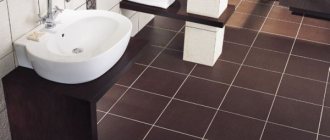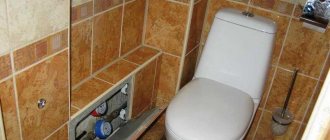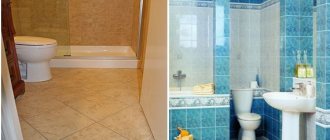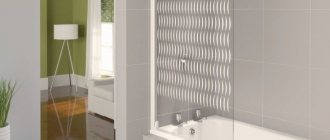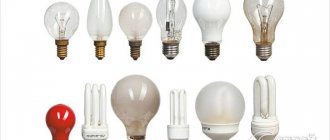Forced ventilation is designed to provide a comfortable microclimate in the bathroom. High humidity and sudden temperature changes lead to the formation of condensation and the development of pathogens. Before connecting a bathroom fan to a switch, you should evaluate the operating conditions and select a model of suitable power.
Checking natural ventilation
Before installing a fan in the bathroom, you need to determine how well the natural exhaust works. This is done in a simple way: take a sheet of thin paper or unfold a napkin; open a window in any room; attach the paper to the hood opening. If the napkin is immediately drawn to the hole, this means that natural suction is working correctly. If the napkin does not attract, then you should think about installing a fan in the bathroom.
You can check the effectiveness of the hood by holding a lit match or lighter to the hole. If the flame deviates strongly towards the channel, then the ventilation is working normally. Otherwise, if the flame deflection is weak or if it burns evenly, an exhaust cooler will be required.
Stagnant air in a bathroom or toilet leads to the formation of high humidity in the room and, as a result, to the appearance of fungus on the walls. How harmful mold fungus is to human health is not worth talking about.
If you are convinced that the ventilation duct is clogged, you can clear it by lowering a cone-shaped weight into it. If for some reason you cannot do this, contact the utility service, they will tell you which organization you need to apply to.
Norms and requirements
Let's study SNIPs and other regulatory documents in order to understand how much new air should come into the bathroom or toilet during ventilation.
According to regulatory documentation, bathrooms measuring about 10 square meters or more must receive new inflows of air masses once every hour.
More than 30 cubic meters should leave the bathroom and toilet every hour. If the bathroom is large, then the calculation is based on the area of a small living room and multiplied by 1.5 (due to high humidity). These are the ventilation standards, these numbers are the minimum requirements.
Selecting an exhaust cooler
Before installing a fan in the bathroom, you need to take measurements of the width, height and depth of the vent and write down the data obtained. Based on this information, you should choose fans in the store.
Calculating the cooler power is very important before purchasing a hood. According to sanitary standards, the air in the bathroom should be changed 6-8 times within 1 hour, and fans should cope with this task. The power is calculated using the following formula: L = V * K, where L is the volume of air for complete air exchange (m3/h), V is the volume of the room, and K is the air exchange coefficient (how many times the air must be changed in 1 hour).
Calculation example: Room length – 2.5 m, width – 3.2 m, height 2.8 m. Let’s find out the volume of the room: V = 2.5 * 3.2 * 2.8 = 22.4 m3. Next, we substitute the result obtained into the formula: L = 22.4 * 8 = 179.2 m3/h. Based on the calculation, the cooler should pass through 179.2 m3/h of air in 1 hour. When choosing a device, it is recommended to choose a model that will be 20% more powerful than the calculated one. That is, the unit must have a power reserve. In this case, to install a fan in a toilet or bathroom with such a volume, a cooler with a capacity of 200 m3/h will be sufficient.
These calculations are also relevant if you want to install a fan in the kitchen.
The installation of an exhaust fan in a bathroom is regulated by permissible noise standards. Since increasing the power of the device inevitably increases its noise, when choosing a unit you should adhere to the standard: the sound intensity from the operation of the cooler should not exceed 30 dB.
Recommendations from experts
- Experts advise not to put off inspecting the ventilation system until later; it is highly advisable to service the fans a little earlier before they begin to fail.
- As a rule, if inspection is constantly delayed, then flakes of dust, cobwebs or poplar fluff get into the fan axis, block the rotor and stator motor for a long time, after which the fan simply fails.
- Of course, buying a new motor or fan entirely is a simple solution to this issue, but you will still have to clean the ventilation duct. It is much easier to do this work on time.
- Do-it-yourself steps regarding fans include cleaning the blades of the fan propellers, thoroughly cleaning the ventilation grilles and replacing all filters (if any).
- After this, you need to check the air draft using a sheet of paper or the flame of a lighter (we described above how this procedure is performed). If the flame from the lighter (or match) is deflected at an angle of 40-50 degrees, then the operation of the fan is considered normal; if the flame does not deflect, then the ventilation duct is considered clogged and further operation of the fan is a load.
- In such cases, it is best to call a specialist, but you can also handle it yourself. If the ventilation system includes various attachments - external interfaces, sensors, thermometers, remote controls, then you should definitely contact a special organization.
- Experts also pay special attention to the power of household wiring and electrical networks. Fans have two parameters by which they are distinguished - the pressure created and power. These characteristics are related because the greater the motor power, the greater the pressure. You need to know the condition of your wiring well and try to avoid high-power fans.
Connection diagrams
There are 4 circuits for connecting an exhaust fan in a bathroom. But, if you carry out installation work and manipulate electrical wiring with your own hands, take care, first of all, about safety rules. It is necessary to turn off the required switch on the electrical panel so that there is no voltage on the wiring in the place where you will work.
All circuits are designed for three- or two-wire wiring. If the wiring is two-wire, then the units are connected without grounding.
Connection from a light bulb
The connection diagram for a bathroom fan, which involves connecting to a lighting fixture, is quite simple and is shown in the figure below.
The only drawback of this connection is that the ventilation will only work when the light bulb is on.
Connection via a separate switch
To avoid the disadvantage described above, there is a way to connect the cooler via a switch. The wiring diagram in this case is also not complicated, and even a non-specialist can understand how to connect a fan in the bathroom to a switch.
To connect equipment according to this scheme, you will need to install a two-key switch. One key will be used when turning on the lighting, the second will be used to start the hood. You will need to run a “zero” wire to the cooler, connecting to the “zero” of the light bulb, which is laid from the junction box. The phase from the distribution box must be brought to the switch and connected to two contacts going to the cooler and the light bulb.
Cooler with timer
Coolers equipped with a timer are much more convenient to use. But the cost of such equipment is higher. The connection diagram for a fan with a timer is shown below.
A cooler equipped with a timer works according to the following principle:
- when the lighting is turned on, the unit starts working;
- after turning off the light, the fan with a timer continues to work for some time (preset), removing excess moisture and odors from the bathroom or toilet, after which it turns off.
The fan with a timer is connected using four wires: L – phase from the junction box, LT – wire from the light bulb switch, ground wire and N – “zero”.
Device with sensors
If you are planning to install and connect a fan in the bathroom, then you should pay attention to devices equipped with humidity or motion sensors. The operation of such fans in the bathroom and toilet is completely autonomous and does not require any participation from you.
For the toilet, an installed device with a motion sensor and a timer will be sufficient. When a person enters the toilet, a sensor in the unit will detect movement and turn on the hood. When a person leaves the bathroom, the sensor will give a command to turn off, but the device will turn off only after the time set on the timer has expired.
Installing a unit such as a fan with a humidity sensor in the bathroom means making an ideal solution in the fight against dampness in this room . If the humidity in the room rises to the maximum set limits, the cooler will automatically start working. Once normal humidity levels are reached, the unit will stop. Thanks to this sensor, the bathroom will always be fresh and dry.
The following figure shows a diagram to help you install a sensor-equipped exhaust fan.
Connecting a fan without a timer
This connection option is considered the simplest from a technical point of view. The switch is placed in front of the entrance to the bathroom or indoors. It is advisable to install it away from plumbing equipment, where splashes on electrical contacts are prevented.
Plastic axial fans do not have a terminal output for connecting a ground loop. Everything is limited to phase switching with a neutral conductor. Connections are made in a distribution panel or socket box up to 60 mm deep.
To a separate switch
This is the most common connection option.
You will need to perform the following wiring connections:
- the neutral conductors of the ventilation unit and the electrical network are connected and insulated;
- the hood and switch phases are paired in the same way;
- The phase conductor of the electrical network is connected to the input terminal of the switch.
An important condition is the connection of the ground loop.
To the switch shared with the light
It is convenient when the ventilation unit starts at the same time as the lighting fixtures are turned on. The most practical option is to combine it with a two- or three-key switch. A socket box is installed in the corresponding hole. Electrical switching is carried out in it.
The input terminal is connected to the phase conductor of the power supply network. The output contact closes to the phase of the climate control unit. After connection, it is necessary to check the reliability of the connection and the integrity of the insulation. Then the working mechanism is fixed in the socket box and the cover with keys is installed.
Wall mounting
Under the decorative fan panel there are holes for attaching the case to a wall or ceiling. Therefore, you should attach the device to the hole in the vent (sometimes you have to expand the vent) and use a pencil to mark the places for drilling.
Next, in the places where you marked, you need to drill holes using a hammer drill or impact drill. For the latter, it is necessary to use a drill with a “concrete” solder. After drilling the holes, hammer plastic dowels into them, insert the cooler into the vent and secure it with self-tapping screws.
Attention! Before connecting the fan in the toilet or bathroom, do not forget to turn off the general switch for your apartment or the circuit breakers under the electric meter.
Now that the equipment is installed, you can connect the wires using the diagrams above.
There is another option with which you can install a fan in the toilet or bathroom without using power tools:
- purchase liquid nails or silicone glue at the store;
- clean the surface of the wall where the cooler is attached from plaster or whitewash;
- Apply glue around the vent using a gun or squeezing it out with the handle of a hammer;
- insert the cooler into the vent and check the horizontal position using a level;
- fix the device in this position with tape;
- after 2-3 hours, the fixation can be removed;
- After connecting the wires and returning the decorative panel to its place, the installation of the fan in the bathroom is complete.
For clarity and better understanding of the material, you can watch the following video.
Diagnostics of the current system, if available
Before you start upgrading your ventilation system or cleaning its filters, it is necessary to carry out routine diagnostics. The condition of the ventilation device installed according to the “to the bathtub through the toilet” principle must be studied thoroughly. There is no need to be lazy in removing the grilles and cleaning the inlets and outlets of the channels from dust.
First you need to find the causes of poor draft and check the ventilation system. To do this, place a sheet of paper in front of the ventilation hole. If the paper sheet is strongly attracted to the ventilation niches, then there is draft. If the sheet is motionless, there is a clear lack of ventilation draft in the system.
It must be remembered that the design of the system is such that the pressure difference is due to the temperature difference, therefore on a hot summer day the draft is several times weaker than in winter or autumn.
However, even if draft is present and the exchange of air masses occurs perfectly, it is necessary to understand that this does not guarantee 100% complete operation of the ventilation systems.
It is imperative to check the channel status as much as possible as the situation allows. Channels can be cluttered with various objects, cobwebs, dust or fragments of concrete and brick after global repairs. Once the system is clean, there are no more obstacles in the way of air, and the ventilation devices themselves are clean, you can begin to modernize and improve the system itself.
The test with a sheet of paper must be carried out twice: the first time with the doors closed, the second time with the doors open.
It is advisable to carry out the check when the door is open, too, twice - with open air sources (open a window or front door) and with completely closed ones.
If after sealing the draft drops to almost zero, then you need to think about additional fans or compact ventilation devices.
Special grilles are installed in the doors of bathrooms and toilets - through them air flows inside even when the doors are completely closed.
Ceiling installation
An exhaust fan in a bathroom or toilet can also be installed on the ceiling (suspended or suspended).
Ceiling placement is often used in private homes, when the ventilation duct can be drawn through the ceiling and laid through the attic . In such cases, it is recommended to use duct fans, which are also located in the attic.
In the case of a suspended or suspended ceiling, the situation becomes a little more complicated. It would be wiser if, before installing various types of ceilings, you prepare a place for installing equipment. The grate or cooler can be screwed to the drywall using a butterfly dowel. In the case of a suspended ceiling, the equipment is attached to a pre-installed stand.
If the suspended ceiling is already installed, then to install the cooler and carry out all communications it will have to be dismantled.
Of course, dismantling a suspended ceiling is a rather difficult task, and few people will do this to install a fan. There are 2 solutions:
- you can try to pull the wires through a pre-made hole in the right place, and then seal it so that it becomes invisible;
- run the wiring from the connected unit directly along the ceiling and hide it with a cable duct.
In any case, when installing ventilation equipment yourself, it is important to consistently carry out the above operations without haste, in compliance with safety rules and with great care, especially if the installation is carried out on a suspended ceiling.
Choosing a fan for the bathroom
Household models have small dimensions and low power compared to units for industrial purposes.
According to the design and method of intake of the air mixture, they are divided into 2 types:
- Axial.
- Radial.
The first are equipped with blades that capture air and direct it parallel to the central axis of the device. Radial fans have a special impeller. It is designed to change the direction of atmospheric flow.
Axial models are the most common in everyday life. Their installation does not require special skills or technical training. Fans are classified according to the type of installation: duct and overhead.
The first option is characterized by higher performance and low noise. Such models are mounted in air ducts. In a private house you can install any type of fan, but in a city apartment - only an overhead fan.
When choosing a suitable device you should consider:
- Noise level.
- Power.
- Bearing type.
- Moisture protection class.
The performance rating and noise level are indicated in the supplied user manual and printed on the packaging. Depending on the size of the bathroom, it is recommended to purchase a device with a capacity of 50-250 m³/h. The noise level that is comfortable for human hearing is in the range of 25-30 dB. Since the fan will have to operate in conditions of high humidity and sudden temperature fluctuations, it is advisable to give preference to a model with a protection class of at least IP44.
Division of ventilation systems into types
Ventilation systems can be divided into two types:
- natural ventilation;
- artificial ventilation.
When air masses move without additional influence, this is called natural ventilation. Air moves from an area of high pressure to an area of lower pressure. Special devices do not “adjust” it.
Scheme of natural ventilation of the apartment





